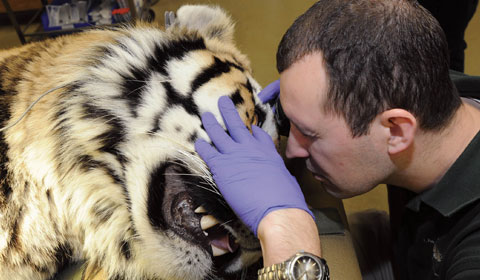News Release
Contact: Sondra Katzen, Public Relations, 708.688.8351,
sondra.katzen@czs.org
March 4, 2022
FOR IMMEDIATE RELEASE
NOTE: Scroll down to end of press release to download photos.
Humboldt Penguin Chick Hatches at Brookfield Zoo
Brookfield, Ill. —A month-old Humboldt penguin chick, who hatched at Brookfield Zoo on February 2, is growing by leaps and bounds. The chick is only the second successful offspring for parents—14-year-old Divot and 21-year-old Rosy—making its hatching extremely significant to the Humboldt penguin population in Association of Zoos and Aquariums’ (AZA) accredited North American institutions.
The pairing of Divot, who hatched at Brookfield Zoo in 2008, and Rosy, who arrived in 2013, was based on a recommendation from the AZA’s Species Survival Plan (SSP), a cooperative population management and conservation program. Each SSP manages the breeding of a species to maintain a healthy and self-sustaining population that is both genetically diverse and demographically stable. Divot and Rosy, who have been together since her arrival, are the most genetically valuable pair at Brookfield Zoo because they are considered underrepresented in the overall AZA Humboldt penguin population. Brookfield Zoo, which has 30 Humboldt penguins in breeding and non-breeding colonies, is one of 20 AZA institutions to care for the species.
The unsexed chick is currently being hand-reared by animal care staff. In the wild, Humboldt penguin parents typically stay and care for their chicks until the young are about 70 to 90 days old. The adults then leave the breeding ground and go off to sea, leaving their young to fend for themselves. Prior to the chick reaching that age, and to mimic the natural cycle as well as to improve the health and welfare of the birds, at Brookfield Zoo, when a chick reaches a certain weight, animal care staff take over. The chick still knows it is a penguin, but the shift from parent-feeding to self-feeding makes for an easier transition on both the adults and the young bird. It also allows care staff to better monitor the chick’s food intake.
According to IUCN’s (International Union for Conservation of Nature and Natural Resources) Red List, Humboldt penguins are “vulnerable” in their native habitat along the western coast of South America near Peru and Chile. The penguin population, which researchers estimate to be less than 24,000, continues to decline due to several factors, including climate change and severe weather, human encroachment, energy production mining, and pollutants among other threats.
Guests can see the Humboldt penguins at Brookfield Zoo’s Living Coast habitat. For those interested in a more up-close experience, the zoo offers two programs—Penguin Encounter, which allows participants to mingle with and possibly touch a penguin, and Penguin Feeding Adventure that provides the opportunity to feed the charismatic birds. For information about these two programs, go to CZS.org/PlanYourVisit.
Additionally, to help in the care of the Humboldt penguins at Brookfield Zoo, penguin enthusiasts can contribute to the Animal Adoption program. For $35, a recipient receives the Basic Package that includes a 5-inch x 7-inch color photograph of a Humboldt penguin, a personalized certificate of adoption, a Humboldt penguin fact sheet, an Animal Adoption program decal, and an invitation to the exclusive 2022 Animal Adoption summer event. To purchase, visit www.CZS.org/AnimalAdoption.
# # #
Photo Captions (credit: Jim Schulz/CZS-Brookfield Zoo)
0526 and
0544: A month-old Humboldt penguin chick hatched at Brookfield Zoo on February 2. According to IUCN’s (International Union for Conservation of Nature and Natural Resources) Red List, Humboldt penguins are “vulnerable” in their native habitat along the western coast of South America near Peru and Chile. The penguin population, which researchers estimate to be less than 24,000, continues to decline due to several factors, including climate change and severe weather, human encroachment, energy production mining, and pollutants among other threats.
0548 and
0555: Emily Macko, a senior animal care specialist at Brookfield Zoo, holds a Humboldt penguin chick who hatched on February 2.
About the Chicago Zoological Society
The mission of the Chicago Zoological Society is to inspire conservation leadership by engaging people and communities with wildlife and nature. The Chicago Zoological Society is a private nonprofit organization that operates Brookfield Zoo on land owned by the Forest Preserves of Cook County. The Society is known throughout the world for its international role in animal population management and wildlife conservation. Its Center for the Science of Animal Care and Welfare is at the forefront of animal care that strives to discover and implement innovative approaches to zoo animal management. Brookfield Zoo is the first zoo in the world to be awarded the Humane Certified™ certification mark for the care and welfare of its animals, meeting American Humane Association’s rigorous certification standards. The zoo is located at 8400 31st Street in Brookfield, Illinois, between the Stevenson (I-55) and Eisenhower (I-290) expressways and also is accessible via the Tri-State Tollway (I-294), Metra commuter line, and CTA and PACE bus service. For further information, visit
CZS.org.
MEDIA CONTACT:
Sondra Katzen
Media Relations Manager
Office: 708-688-8351
Cell Phone: 708-903-2071
E-mail: Sondra.Katzen@CZS.org

Read about our innovative practices in animal welfare to ensure the ultimate care of our individual animals.

Create extraordinary connections with animals and nature!

Become our partner in caring for animals and in connecting people with wildlife and nature.